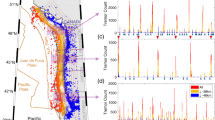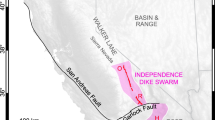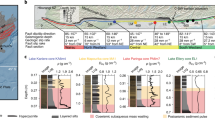Abstract
The deep extension of the San Andreas Fault is believed to be creeping, but the recent observations of tectonic tremors from these depths indicate a complex deformation style1. In particular, an isolated tremor source near Parkfield has been producing a sequence of low-frequency earthquakes2 that indicates an uncommon mechanism of stress accumulation and release. The tremor pattern regularly oscillated between three and six days from mid-2003 until it was disrupted by the 2004 magnitude 6.0 Parkfield earthquake. After that event, the tremor source ruptured only about every three days, but over the next two years it gradually returned to its initial alternating recurrence pattern. The mechanism that drives this recurrence pattern is unknown. Here we use physics-based models to show that the same tremor asperity—the region from which the low-frequency earthquakes radiate—can regularly slip in slow and fast ruptures, naturally resulting in recurrence intervals alternating between three and six days. This unusual slip behaviour occurs when the tremor asperity size is close to the critical nucleation size of earthquakes. We also show that changes in pore pressure following the Parkfield earthquake can explain the sudden change and gradual recovery of the recurrence intervals. Our findings suggest a framework for fault deformation in which the same asperity can release tectonic stress through both slow and fast ruptures.
This is a preview of subscription content, access via your institution
Access options
Subscribe to this journal
Receive 51 print issues and online access
$199.00 per year
only $3.90 per issue
Buy this article
- Purchase on Springer Link
- Instant access to full article PDF
Prices may be subject to local taxes which are calculated during checkout



Similar content being viewed by others
References
Shelly, D. R. Migrating tremors illuminate complex deformation beneath the seismogenic San Andreas Fault. Nature 463, 648–652 (2010)
Shelly, D. R. Periodic, chaotic, and doubled earthquake recurrence intervals on the deep San Andreas Fault. Science 328, 1385–1388 (2010)
Shelly, D. R. Complexity of the deep San Andreas Fault zone defined by cascading tremor. Nature Geosci. 8, 145–151 (2015)
Ito, Y., Obara, K., Shiomi, K., Sekine, S. & Hirose, H. Slow earthquakes coincident with episodic tremors and slow slip events. Science 315, 503–506 (2007)
Schwartz, S. Y. & Rokosky, J. M. Slow slip events and seismic tremor at circum-Pacific subduction zones. Rev. Geophys. 45, RG3004 (2007)
Daub, E. G., Shelly, D. R., Guyer, R. A. & Johnson, P. A. Brittle and ductile friction and the physics of tectonic tremor. Geophys. Res. Lett. 38, L10301 (2011)
Ghosh, A., Vidale, J. E. & Creager, K. C. Tremor asperities in the transition zone control evolution of slow earthquakes. J. Geophys. Res. 117, B10301 (2012)
Gu, Y. & Wong, T.-F. in Nonlinear Dynamics and Predictability of Geophysical Phenomena (eds Newman, W. I., Gabrielov, A. & Turcotte, D. L. ) 15–35 (Geophys. Monogr. 83, AGU, 1994)
Dieterich, J. H. Modeling of rock friction 1. Experimental results and constitutive equations. J. Geophys. Res. 84, 2161–2168 (1979)
Scholz, C. H. Earthquakes and friction laws. Nature 391, 37–42 (1998)
Lapusta, N. & Barbot, S. in The Mechanics of Faulting: From Laboratory to Real Earthquakes (eds Bizzarri, A. & Bhat, H. S. ) 153–207 (Research Signpost, 2012)
Noda, H. & Lapusta, N. Three-dimensional earthquake sequence simulations with evolving temperature and pore pressure due to shear heating: effect of heterogeneous hydraulic diffusivity. J. Geophys. Res. 115, B12314 (2010)
Barbot, S., Lapusta, N. & Avouac, J.-P. Under the hood of the earthquake machine: towards predictive modeling of the seismic cycle. Science 336, 707–710 (2012)
Rubin, A. M. & Ampuero, J.-P. Earthquake nucleation on (aging) rate and state faults. J. Geophys. Res. 110, B11312 (2005)
Liu, Y. & Rice, J. R. Spontaneous and triggered aseismic deformation transients in a subduction fault model. J. Geophys. Res. 112, B09404 (2007)
Matsuzawa, T., Hirose, H., Shibazaki, B. & Obara, K. Modeling short- and long-term slow slip events in the seismic cycles of large subduction earthquakes. J. Geophys. Res. 115, B12301 (2010)
Noda, H. & Hori, T. Under what circumstances does a seismogenic patch produce aseismic transients in the later interseismic period? Geophys. Res. Lett. 41, 7477–7484 (2014)
Rubinstein, J. L. et al. Non-volcanic tremor driven by large transient shear stresses. Nature 448, 579–582 (2007)
Peng, Z. et al. Strong tremor near Parkfield, CA, excited by the 2002 Denali Fault earthquake. Geophys. Res. Lett. 35, L23305 (2008)
Thomas, A. M., Nadeau, R. M. & Bürgmann, R. Tremor-tide correlations and near-lithostatic pore pressure on the deep San Andreas Fault. Nature 462, 1048–1051 (2009)
Ide, S. Striations, duration, migration and tidal response in deep tremor. Nature 466, 356–359 (2010)
Brenguier, F. et al. Postseismic relaxation along the San Andreas Fault at Parkfield from continuous seismological observations. Science 321, 1478–1481 (2008)
Segall, P., Rubin, A. M., Bradley, A. M. & Rice, J. R. Dilatant strengthening as a mechanism for slow slip events. J. Geophys. Res. 115, B12305 (2010)
Rubin, A. M. Designer friction laws for bimodal slow slip propagation speeds. Geochem. Geophys. Geosyst. 12, Q04007 (2011)
Ito, Y. et al. Episodic slow slip events in the Japan subduction zone before the 2011 Tohoku-Oki earthquake. Tectonophysics 600, 14–26 (2013)
Meng, L., Huang, H., Bürgmann, R., Ampuero, J.-P. & Strader, A. Dual megathrust slip behaviors of the 2014 Iquique earthquake sequence. Earth Planet. Sci. Lett. 411, 177–187 (2015)
Shelly, D. R. & Hardebeck, J. L. Precise tremor source locations and amplitude variations along the lower-crustal central San Andreas Fault. Geophys. Res. Lett. 37, L14301 (2010)
Tape, C., Plesch, A., Shaw, J. H. & Gilbert, H. Estimating a continuous Moho surface from the California Unified Velocity Model. Seismol. Res. Lett. 83, 728–735 (2012)
Lapusta, N. & Liu, Y. Three-dimensional boundary integral modeling of spontaneous earthquake sequences and aseismic slip. J. Geophys. Res. 114, B09303 (2009)
Harris, R. A. et al. The SCEC/USGS dynamic earthquake rupture code verification exercise. Seismol. Res. Lett. 80, 119–126 (2009)
Chen, T. & Lapusta, N. Scaling of small repeating earthquakes explained by interaction of seismic and aseismic slip in a rate and state fault model. J. Geophys. Res. 114, B01311 (2009)
Kaneko, Y., Avouac, J.-P. & Lapusta, N. Towards inferring earthquake patterns from geodetic observations of interseismic coupling. Nature Geosci. 3, 363–369 (2010)
Marone, C. Laboratory-derived friction laws and their application to seismic faulting. Annu. Rev. Earth Planet. Sci. 26, 643–696 (1998)
Ruina, A. Slip instability and state variable friction laws. J. Geophys. Res. 88, 10359–10370 (1983)
Rice, J. R. & Ruina, A. L. Stability of steady frictional slipping. J. Appl. Mech. 50, 343–349 (1983)
Dieterich, J. H. in Treatise on Geophysics Vol. 4, Earthquake Seismology (ed. Kanamori, H. ) 107–129 (Elsevier Science, 2007)
Rice, J. R. & Ben-Zion, Y. Slip complexity in earthquake fault models. Proc. Natl. Acad. Sci. 93, 3811–3818 (1996)
Marone, C. & Kilgore, B. Scaling of the critical slip distance for seismic faulting with shear strain in fault zones. Nature 362, 618–621 (1993)
Rice, J. R., Lapusta, N. & Ranjith, K. Rate and state dependent friction and the stability of sliding between elastically deformable solids. J. Mech. Phys. Solids 49, 1865–1898 (2001)
Beeler, N. M., Thomas, A., Bürgmann, R. & Shelly, D. R. Inferring fault rheology from low-frequency earthquakes on the San Andreas. J. Geophys. Res. 118, 5976–5990 (2013)
Peng, Z., Vidale, J. E., Wech, A. G., Nadeau, R. M. & Creager, K. C. Remote triggering of tremor along the San Andreas Fault in central California. J. Geophys. Res. 114, B00A06 (2009)
Shelly, D. R., Peng, Z., Hill, D. P. & Aiken, C. Triggered creep as a possible mechanism for delayed dynamic triggering of tremor and earthquakes. Nature Geosci. 4, 384–388 (2011)
Thomas, A. M., Bürgmann, R., Shelly, D. R., Beeler, N. M. & Rudolph, M. L. Tidal triggering of low frequency earthquakes near Parkfield, CA: implications for fault mechanics within the brittle-ductile transition. J. Geophys. Res. 117, B05301 (2012)
Zigone, D. et al. Triggering of tremors and slow slip event in Guerrero, Mexico, by the 2010 Mw 8.8 Maule, Chile, earthquake. J. Geophys. Res. 117, B09304 (2012)
Noda, H. & Lapusta, N. Stable creeping fault segments can become destructive as a result of dynamic weakening. Nature 493, 518–521 (2013)
Barbot, S. & Fialko, Y. A unified continuum representation of post-seismic relaxation mechanisms: semi-analytic models of afterslip, poroelastic rebound and viscoelastic flow. Geophys. J. Int. 182, 1124–1140 (2010)
Acknowledgements
We thank D. R. Shelly for sharing his tremor data and J.-P. Avouac for his comments on an earlier version of the manuscript. This work comprises Earth Observatory of Singapore contribution no. 115. S.B. is funded by the National Research Foundation Singapore under its Singapore NRF Fellowship scheme (National Research Fellow Award no. NRF-NRFF2013-04), by the Earth Observatory of Singapore, by the National Research Foundation Singapore and by the Singapore Ministry of Education under the Research Centres of Excellence initiative.
Author information
Authors and Affiliations
Contributions
D.M.V. and S.B. designed the experiment, analysed the data, and wrote the paper.
Corresponding authors
Ethics declarations
Competing interests
The authors declare no competing financial interests.
Extended data figures and tables
Extended Data Figure 1 Numerical model of the Parkfield tremors.
a, Schematic diagram of the model geometry and frictional properties. A square velocity-weakening patch (yellow) is embedded in a large velocity-strengthening fault domain. R is the asperity size of the patch. The entire fault domain is driven by a plate rate of Vpl = 3 cm yr−1. h* (dotted circle) is the critical nucleation size of the velocity-weakening patch to generate elasto-dynamic slip. We use the ratio R/h* = 0.73. The model has R = 3 m, L = 5 μm and an effective confining pressure of  = 50 MPa, but period-doubling recurrence intervals at three and six days can be obtained for various asperity sizes, as discussed in the text. b, The yellow square patch in a produces a succession of slow and fast ruptures. Fast ruptures may be detected in seismograms and may coincide with one of the LFEs. The model reproduces the period-doubling recurrence pattern of the Parkfield tremors before the 2004 Parkfield earthquake.
= 50 MPa, but period-doubling recurrence intervals at three and six days can be obtained for various asperity sizes, as discussed in the text. b, The yellow square patch in a produces a succession of slow and fast ruptures. Fast ruptures may be detected in seismograms and may coincide with one of the LFEs. The model reproduces the period-doubling recurrence pattern of the Parkfield tremors before the 2004 Parkfield earthquake.
Extended Data Figure 2 Recurrence pattern and source characteristics of the period-doubling Parkfield tremors and numerical simulations with slip velocity.
a–d, Same as Fig. 2, but plotting slip velocity (instead of slip) in c and d.
Extended Data Figure 3 Simulations of period-doubling sequences of slow and fast ruptures along eight orders of magnitude.
All simulations assume the same rheological parameters except for the characteristic weakening distance L, which is used to adjust the ratio R/h* to within the period-doubling range. a, With R = 3 m and L = 5μm, we obtained slow and fast ruptures with an equivalent geodetic moment magnitude of Mw −1.9 and Mw −0.5. b, With R = 30 m and L = 0.05 mm, the range is Mw 0.07 and Mw 1.4. c, For R = 300 m and L = 0.5 mm, the range is Mw 2.1 and Mw 3.5. d, For R = 3 km and L = 5 mm, the range is Mw 3.9 and Mw 5.4. Square patches of velocity-weakening friction with different sizes may exhibit period doubling at almost all magnitudes. The blue and red lines show aseismic and seismic slip, respectively. VS and VW represent the extent of the velocity strengthening and velocity weakening regions, respectively. Increments refer to the time steps between consecutive profiles (larger for aseismic than for seismic slip).
Extended Data Figure 4 Potential of non-circular shaped asperities to produce complex sequences of slow and fast ruptures with period doubling.
a, c, Velocity-weakening (VW) patches with two different shapes. b, d, The corresponding history of the period separating each event (a and c respectively). For both simulations, we assume the same frictional parameters and confining pressure. Elliptical (and potentially other non-circular) patches can produce period doubling over a wider range of parameters than a circular asperity can. With the parameters considered, the non-circular asperities produce period doubling of recurrence time, but the circular patch does not. The parameters considered are 50 MPa, a = 10−2, L = 5 μm, and the velocity-weakening regions are characterized by (a − b) = −4 × 10−3, while the velocity-strengthening regions have (a − b) = +4 × 10−3. Slip events (seismic and aseismic) are singled out when the slip velocity threshold reaches the value Vth = 10−4 m s−1.
Extended Data Figure 5 Simulation of the recurrence intervals of the period-doubling Parkfield tremors in a larger slip patch with R = 33 m and  = 5 MPa.
= 5 MPa.
a, Numerical simulation of the Parkfield tremor activity incorporating the change in effective pore pressure (red profile) after the Parkfield earthquake (EQ; vertical dashed line). The coloured dots denote the maximum velocity of the slip events. The slip events are flagged when the slip velocity is above the threshold Vpl = 10−4 m s−1 anywhere along the fault. Fast ruptures are preceded by shorter recurrence intervals. A change of pore pressure of about 300 kPa, representing 6% of the effective confining pressure, is applied at the onset of the Parkfield earthquake, resulting in a rapid occurrence of slip events, followed by a sequence of multiplets (highlighted in the two boxes) with varying period-multiplying factors. The pressure perturbation is chosen by trial and error to create a two-year transient that is similar to the seismic observations. The top right inset shows the model geometry with an asperity size R of 33 m. b, Characterization of the dynamics of the slip events. Fast ruptures are preceded by shorter recurrence intervals. The effective pore-pressure perturbation following the Parkfield earthquake affects the dynamics of the sequence with a temporary interruption of period doubling followed by a gradual recovery. See Fig. 2 legend for details of methodology and presentation.
Rights and permissions
About this article
Cite this article
Veedu, D., Barbot, S. The Parkfield tremors reveal slow and fast ruptures on the same asperity. Nature 532, 361–365 (2016). https://doi.org/10.1038/nature17190
Received:
Accepted:
Published:
Issue Date:
DOI: https://doi.org/10.1038/nature17190
This article is cited by
-
Experimental study on the slip evolution of planar fractures subjected to cyclic normal stress
International Journal of Coal Science & Technology (2023)
-
Geological constraints on the mechanisms of slow earthquakes
Nature Reviews Earth & Environment (2021)
-
The slow self-arresting nature of low-frequency earthquakes
Nature Communications (2021)
-
Structural control and system-level behavior of the seismic cycle at the Nankai Trough
Earth, Planets and Space (2020)
-
The generation of large earthquakes
Nature Reviews Earth & Environment (2020)
Comments
By submitting a comment you agree to abide by our Terms and Community Guidelines. If you find something abusive or that does not comply with our terms or guidelines please flag it as inappropriate.




 = 5 MPa.
= 5 MPa.